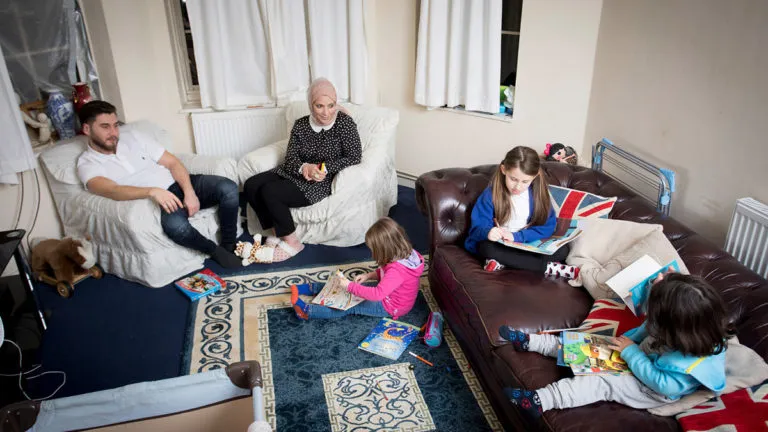The chancellor must lift housing benefit rates
Published: by Jenny Pennington

When the government announced it was ending the freeze on Local Housing Allowance (LHA) – housing benefit for those renting privately – we and millions of households were hopeful. But as of April 2020, the government will lift LHA rates by only a pitiful 1.7%.
As our new assessment of the true impact of LHA shows, after a decade of cuts and freezes, the current proposals are nowhere near enough to provide a stable home for the estimated 1.4 million children who rely on LHA to put a roof over their heads.
Solving homelessness will not happen without building a new generation of genuinely affordable social homes. But these homes cannot be built overnight. To halt the increasing levels of homelessness we have seen over the years from the private sector, LHA must cover the true cost of renting. We urgently need a sustainable future for millions currently affected by the housing emergency.
What’s happened?
In 2011, the government set LHA rates so that LHA claimants would be able to afford at least 30% of the rental market in each local area, otherwise known as the 30th percentile. The minister responsible at the time said that this would match ‘the typical rent for a low-income working household’. This would provide just enough to help families find an affordable home, or cover their rent during a period of low income or job loss.
But since this time, LHA has seen almost a decade of decline. Meanwhile, rents in England have increased by 15%[1] – and in some areas, by far more.[2] LHA rates have fallen behind, and have never been reset to make sure they still cover the cost of ‘the typical rent for a low-income working household’.
We have now reached a stage where the whole of England (97% of areas) is unaffordable to families on LHA. And the government’s current proposed action will do little or nothing to tackle this.
We need action, now
Although the government plans to increase the rates by inflation (currently 1.7%), we know this will make very little difference. For many things will actually get worse. Rent rises across England mean that in more than half of areas, the shortfall between rents and the LHA rate for a three-bedroom home is actually higher after the 1.7% uplift than before. Worryingly, there are now more areas in England where the shortfall for a three-bedroom home is over £100 per month than there were before the 1.7% uplift.
Our new assessment of the impact of LHA policy shows why further action is desperately needed.
This lack of meaningful change to LHA rates is very worrying, as the impact of inaction on LHA to date has been stark. There is a solid, growing body of evidence from government and academia that the cuts to LHA have led directly to more people becoming homeless. Homelessness from the private sector has risen sharply since the reforms to LHA started. Recent research undertaken by the Local Government Association and Policy in Practice identified ‘a robust correlation between both numbers and proportions of households with an LHA-rent gap and homelessness’.
Millions more are at immediate risk of losing their home. Households with no or a low income have an average shortfall between their rents and their LHA payments of £113 a month. This is higher still in London (£212), the East of England (£140), and the South East (£138). That’s why may households are in an unsustainable situation. The majority of LHA claimants (75%) say they are struggling to pay their rent, one in three (36%) have cut back on food, and nearly a quarter (23%) are paying their rent with a credit card.
Not only this but there are particular groups that are disproportionately impacted by LHA cuts. Families with children, lone parent households, women, disabled adults, and households who are BAME are all more likely to be affected, because they’re all more likely to be claiming LHA or be living in the private sector. It’s very important that policy doesn’t disadvantage them further.
And the cuts mean that councils struggle to help families prevent or resolve homelessness, because there are no available homes that are affordable to people who receive LHA. With no social housing, councils must increasingly rely on the private sector, which is often too expensive for LHA claimants. Nine in ten councils in England report difficulty in preventing or resolving homelessness through accessing the private rental sector as a result of inadequate LHA rates.[3]
Families have no other choice
Here’s the real kicker though – two-thirds of families on LHA are employed. They’re already doing everything they can to keep a stable roof over their heads.
Are we really willing to stand by while more and more families are plunged into poverty, debt and homelessness?
These 1.4 million children can’t wait. The government must invest in LHA so that we can make the homes that we have already (in the private sector) affordable for families now.
The Budget on 11 March is an opportunity for the chancellor to end this desperate situation. We urge him to take it. Ensure that LHA rates are reset at the 30th percentile of local rents or above to help families now, as well as investing in a new generation of social housing to solve the housing crisis for good.
[1] ONS, Index of Private Housing Rental Prices, UK: monthly estimates
[2] ONS, Index of Private Housing Rental Prices, UK: monthly estimates, Table 1.
[3] Fitzpatrick, S., Pawson, H., Bramley, G., Wilcox, S., Watts, B, The homelessness monitor: England 2017, Crisis, Heriot-Watt University and University of New South Wales, 2017